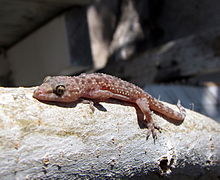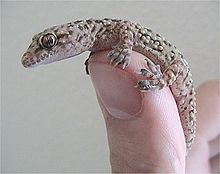- Mediterranean house gecko
-
Mediterranean House Gecko Mediterranean Gecko, Hemidactylus turcicus Scientific classification Kingdom: Animalia Phylum: Chordata Class: Reptilia Order: Squamata Suborder: Sauria Family: Gekkonidae Genus: Hemidactylus Species: H. turcicus Binomial name Hemidactylus turcicus
(Linnaeus, 1758)Mediterranean House Gecko, or more commonly Turkish Gecko as it is represented in its Latin name Hemidactylus turcicus is a species of gecko. They are nocturnal and insectivorous, rarely exceeding 15 centimetres (5.9 in) in length, have large, lidless eyes with elliptical pupils, and yellow- or tan-colored skin with black spots, often with stripes on the tail. Their bellies or undersides are somewhat translucent. In countries where the species has been introduced, they are not considered invasive due to their habits and small size; they rarely threaten populations of native animals.[citation needed] Voracious predators on moths and small roaches, they are attracted to outside lights in search of them. They emit a distinctive, high-pitched call somewhat like a squeak or the chirp of a bird, possibly expressing a territorial message.
A study in Portugal found H. turcicus to be totally nocturnal, with the highest activity peak around 2am.[1]
In many parts of the world the range of H. turcicus is increasing, and unlike many other reptiles, they appear to be highly resistant to pesticides. The increase may be explained as a consequence of having few predators in places where they have been introduced, and also of their tendency to take shelter in the cracks and unseen areas of human homes, for example inside walls. Reliance on human habitation has thus contributed to their proliferation, similar to rodents.
Contents
Description
Snout rounded, about as long as the distance between the eye and the ear-opening, 1.25 to 1.3 the diameter of the orbit; forehead slightly concave; ear-opening oval, oblique, nearly half the diameter of the eye. Body and limbs moderate. Digits variable in length, the inner always well developed; 6 to 8 lamellae under the inner digits, 8 to 10 under the fourth finger, and 9 to 11 under the fourth toe. Head with large granules anteriorly, posteriorly with minute granules intermixed with round tubercles. Rostrum four-sided, not twice as broad as deep, with medial cleft above; nostril pierced between the rostrum, the first labial, and three nasals; 7 to 10 upper and 6 to 8 lower labials; mental large, triangular, at least twice as long as the adjacent labials, its point between two large chin-shields, which may be in contact behind it; a smaller chin shield on each side of the larger pair. Upper surface of body covered with minute granules intermixed with large tubercles, generally larger than the spaces between them, suboval, trihedral, and arranged in 14 or 16 pretty, regular longitudinal series. Abdominal scales small, smooth, roundish-hexagonal, imbricate. Males with a short angular series of 4 to 10 (exceptionally 2) preanal pores. Tail cylindrical, slightly depressed, tapering, covered above with minute scales and transverse series of large keeled tubercles, beneath with a series of large transversely dilated plates. Light brown or grayish above, spotted with darker; many of the tubercles white, lower surfaces white.[2]
Geographic distribution
The "med gecko" is one of the most successful species of geckos in the world. Native to southern Europe, it has spread over much of the world and established stable populations far from its origins. Due to this it holds no threatened or endangered status. It can be found in Portugal, Spain, France, Italy (including Lampedusa island, Elba), Albania, Greece, (incl. Kalymnos, Paros, Antiparos, Despotiko, Lesbos, Chios, Limnos, Samos, Samothraki, Milos, Tinos, Crete), Malta, coastal Croatia (except western Istria), Adriatic islands, Cyprus, Turkey, northern Morocco, Algeria, Tunisia, Israel, Palestine, Jordan, Syria, Libya, Egypt, Lebanon, northern Yemen (Socotra Archipelago), Somalia, Eritrea, Kenya, southern Iran, Iraq, Oman, Qatar, Pakistan, India, Balearic Islands (Island Addaya Grande), Canary Islands (introduced to Gran Canaria and Tenerife), Panama, Puerto Rico, Belize, Mexico (Baja California, Chihuahua, Durango, Nuevo Leon, Yucatan; introduced), Cuba (introduced). It has also been introduced to the southern USA (Louisiana, Alabama, Texas, Arizona, Florida, Arkansas, Mississippi, South Carolina, Georgia, Oklahoma, Virginia, Maryland, California, Nevada, New Mexico, Kansas, Tennessee)
See also
- List of reptiles of Italy
Notes
- ^ Mateus, O. & Jacinto, J.J. (2002): Contribution to the study of Hemidactylus turcicus (Reptilia, Gekkonidae): rhythms of activity and microhabitat in Évora, Portugal. P. 136, in S.P.H. [Sociedade Portuguesa de Herpetologia] & A.H.E. [Associación Herpetológica Española] (coord.) Livro de resumos do VII Congresso Luso-espanhol de Herpetologia / XI Congreso Español de Herpetologia. S.P.H. & A.H.E.. Évora, Portugal.
- ^ Boulenger, G. A. (1890) Fauna of British India. Reptilia and Batrachia.
References
- Franklin, Carl J. 1997 Geographic Distribution. Hemidactylus turcicus. Herpetological Review 28 (2): 96
- Burke, Russell L. 1996 Geographic Distribution. Hemidactylus turcicus. Herpetological Review 27 (1): 32
- Davis, W.K. 1974 The Mediterranean gecko, Hemidactylus turcicus in Texas J. of Herpet. 8(1): 77-80.
- Dowling, Richard G. 1996 The Mediterranean Gecko, Hemidactylus turcicus, in Prattville, Alabama Bulletin of the Chicago Herpetological Society 21 (11): 203
- Dundee, H. A. 1984 Hemidactylus turcicus (Mediterranean gecko) Herp Review 15 (1): 20
- Frick, Michael G. 1997 Geographic Distribution. Hemidactylus turcicus Herpetological Review 28 (1): 50
- Husak, Jerry F. 1996 Geographic Distribution. Hemidactylus turcicus Herpetological Review 27 (4): 211
- Jensen, Steve L.;George, Steven G. 1993 Hemidactylus turcicus (Mediterranean gecko). USA: Louisiana Herpetological Review 24 (4): 154
- Knight, C. Michael 1993 A northern range extension of Hemidactylus turcicus in the United States Dactylus 2 (2): 49-50
- Means, Ryan C. 1999 Geographic distribution. Hemidactylus turcicus Herpetological Review 30 (1): 52
- Proudfoot, Glenn;McCoid, Michael James 1996 Geographic Distribution. Hemidactylus turcicus Herpetological Review 27 (2): 87
- Ray, John;Cochran, Betsy 1997 Geographic Distribution. Hemidactylus turcicus Herpetological Review 28 (3): 157
- Williams, Avery A. 1997 Geographic Distribution. Hemidactylus turcicus Herpetological Review 28 (2): 96
External links
Categories:- Reptiles of Africa
- Reptiles of Asia
- Reptiles of Pakistan
- Reptiles of Europe
- Hemidactylus
Wikimedia Foundation. 2010.



